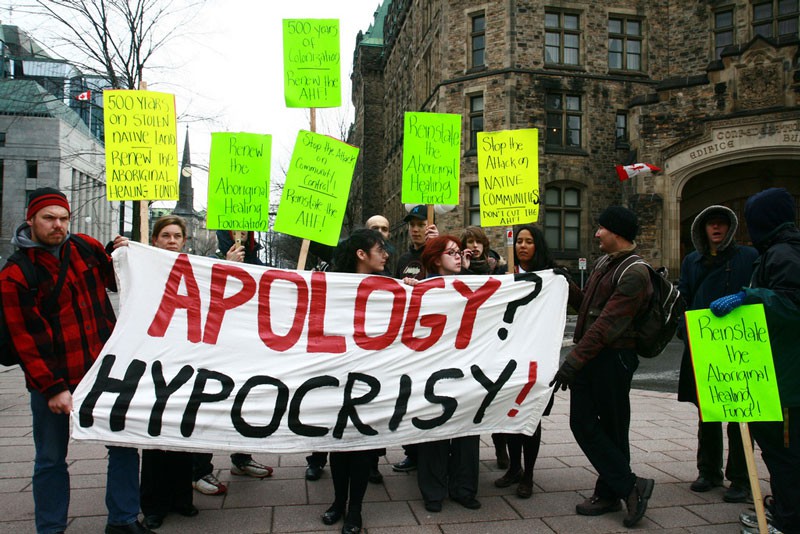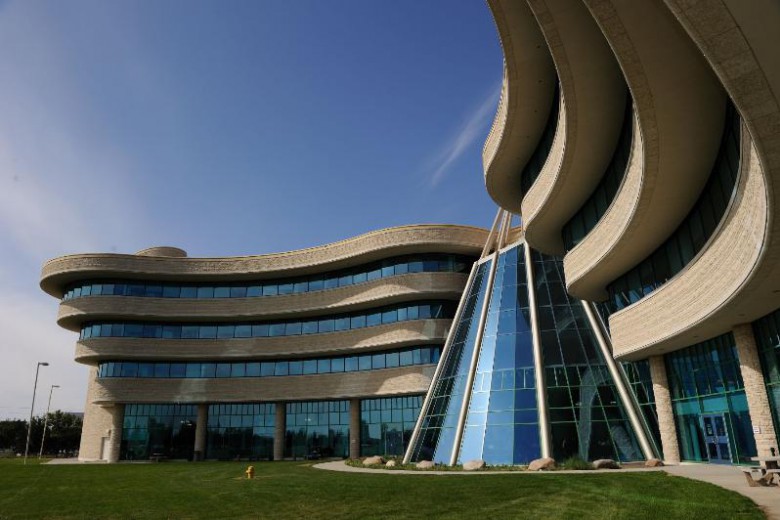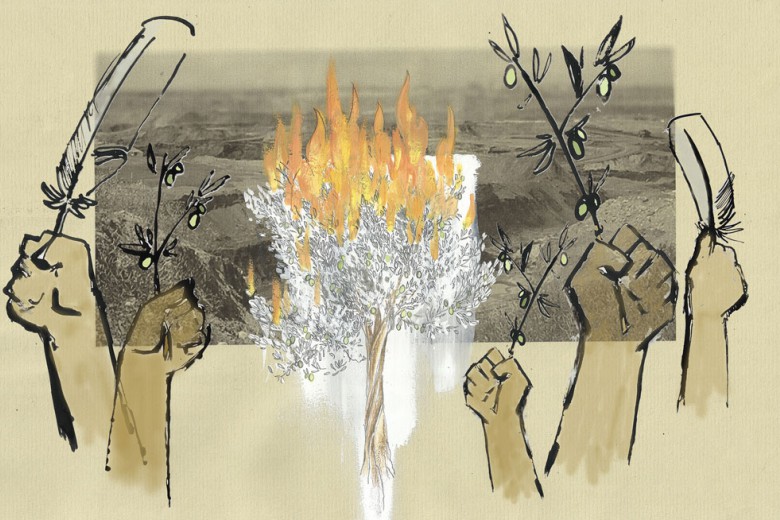
“I’ve been telling people that after we shut down, I will still be available, whether it’s at my house, or through visiting people in their homes,” says Eddie Bitternose, program manager at the Gordon First Nation Residential School Recovery and Wellness Centre in Saskatchewan.
The Centre, which closed its doors at the end of June 2010, was among the 134 native-run healing centres that were forced to shut down or drastically cut back services after the federal government axed funding to the Aboriginal Healing Foundation this spring.
Of the more than 150,000 First Nations, Inuit and Métis children who were forcibly removed from their families and enrolled in one of the many Indian Residential Schools (IRS) in Canada, it is estimated that there are 85,000 residential school survivors in Canada today. Alongside these survivors are the thousands more impacted by the intergenerational effects of residential schools on Aboriginal families.
The last residential school to close down, in 1996, was located in Eddie Bitternose’s own Gordon First Nation, in Saskatchewan. “We had two residential schools in approximately a twenty-mile radius here, an Anglican residential school and a Roman Catholic residential school. I actually attended both schools,” says Bitternose.
In response to mounting pressure from residential school survivors and their communities, the federal government established the Aboriginal Healing Foundation (AHF) in 1998 with a one-time grant of $350 million. The AHF was given a 10-year mandate “to encourage and support, through research and funding contributions, community-based Aboriginal-directed healing initiatives which address the legacy of physical and sexual abuse suffered in Canada’s Indian Residential School System, including intergenerational impacts.”
In 2008, the Foundation’s mandate was extended, but in March 2010, less than two years after Prime Minister Harper’s apology for the Canadian government’s role in administering the Indian Residential School system, AHF funding was eliminated from Canada’s 2010 budget. Many of the healing centres funded by the AHF offered culturally specific, holistic health support programs from within Aboriginal communities themselves, the likes of which are not being offered elsewhere.
Cutbacks and closures
As of March 31, 2010, when the AHF cuts took effect, many healing centres were left with no choice but to cut services that their clients had come to depend on, and others have been forced to begin the process of closing their doors entirely.
The Native Women’s Shelter of Montreal has offered a wide range of holistic and culturally relevant services to native women in Montreal since 1987. The Shelter had been receiving funding from the AHF since the Foundation’s inception in 1998, and the funding cuts announced in March came as a shock to many.
“The AHF was so impressed with the way we’ve been running our services that they wanted to use us as a template for other organizations,” said Nakuset, the Shelter’s executive director (who goes by one name). “I was sure we were going to get more funding.”
In response to the cuts, many staff at the Shelter have taken a pay cut, while at the same time taking on extra responsibilities. Two clinical supervisors are now sharing a salary, and the program coordinator has been laid off indefinitely. The Shelter is no longer able to pay elders to lead workshops, nor can it keep its art therapist. Sweat lodge trips outside the city are also out of the question now. “We’re great workers, and we’re very skilled at multi-tasking. But it wears you down,” says Terri Normandin, the Shelter’s de facto sexual assault counsellor.
Normandin came to the Native Women’s Shelter of Montreal as an outreach client in 1999. It was her connection with the Shelter, their workshops and the employees there that encouraged her to go back to school. It was not long after that that she was hired as the Shelter’s sexual assault counsellor. But with the elimination of AHF funds in March 2010, Normandin’s position was eliminated. She maintains that she is still doing the same job as before, only now she is getting paid less, and is also fulfilling part of the program coordinator portfolio as well.
The Recovery and Wellness Centre in Gordon First Nation is facing similar cutbacks. At the end of March 2010, staff took a 50 per cent pay cut for the remaining three months of the Centre’s operation.
“No equivalent alternative”
A December 2009 evaluation of the AHF undertaken on behalf of Indian and Northern Affairs Canada, less than three months before the elimination of the Foundation, stated that “There is almost unanimous agreement among those canvassed that the AHF has been very successful at both achieving its objectives and in governance and fiscal management… Although evidence points to increasing momentum in individual and community healing, it also shows that in relation to the existing and growing need, the healing ‘has just begun.’”
The report further concluded that “There is presently no equivalent alternative that could achieve the desired outcomes with the rate of success that the AHF has achieved,” and recommended that Canada “continue support for the AHF at least until the Indian Residential Schools Settlement Agreement (IRSSA) process is complete in 2011.”
Inaugurated in 2007, the federally funded IRSSA provides monetary payments to former students who attended one of the 139 officially identified residential schools. The Agreement also includes funding for the AHF.
Despite recognition of the continued need for services offered through the AHF, of the $199 million promised to address the legacy of residential schools in the 2010 budget, none has been committed to the AHF. Half has gone to Health Canada’s First Nations and Inuit Health Branch, and half to the IRSSA for individuals’ compensation.
According to staff who run many of the AHF-supported programs, neither of these is adequate on its own to address the needs of residential school survivors. Stronger critics of the IRSSA reason that no amount of money will solve the problems survivors must face.
“Most of our survivors move away from the counselling and the support system while they have their money [from the IRSSA],” says Eddie Bitternose. “And after they spend their money, they then come back and – well, a lot still feel ripped off.”
NDP Aboriginal Affairs critic Jean Crowder, among others, has pointed out that while nobody is disputing the value of Health Canada services, the ones that they provide are altogether different than those provided by the AHF. Their mandates are, in fact, complementary, and one is lacking without the other.
The AHF provided community-based, native-run programs and services, and many communities formerly served by AHF-funded initiatives do not have Health Canada services in close proximity. Also, many communities are not likely to take advantage of healing programs administered by the same government that backed the Indian Residential School system.
Others will not be able to access Health Canada services even if they try. “I looked at the Health Canada website, and the loops you have to jump through to access services are daunting,” says Crowder.
“I didn’t go to residential school, but my mother did. So I can’t get access to the residential school services that they have through Health Canada. So I fall through the cracks,” says Nakuset.
“Also, there are a lot of First Nations people who do not have their status – it’s either expired, they lost it, or their community is not recognized by the Department of Indian Affairs… How can these people get services through Health Canada when they are not eligible?”
According to Terri Normandin, staff at the Native Women’s Shelter of Montreal are now trying to help clients access services that the Shelter can no longer provide, rather than devoting their time and expertise to the healing programs they developed.
“Our women come here sometimes with completely no ID. And now that we have to help them get their status cards and their medicare cards, we can’t give them services. Now we’re focusing on ‘let’s get you that ID,’ because we want them to have services.” she says.
No public announcement has yet been made regarding Health Canada’s plans to take over responsibility for the services that the AHF was providing to families and communities.
Unfortunate timing
The Truth and Reconciliation Commission (TRC) is a component of IRSSA, and has a five-year mandate to shed light on the injustices experienced by those who lived through the residential school system and the need for continued healing, as well as to provide a platform for survivors to share their stories. The TRC began its work of taking testimonies from survivors across the country in mid-June 2010, with a series of hearings in Winnipeg.
Critics of the TRC, including many indigenous activists across the country, have pointed out that survivors are not allowed to name their abusers, eliminating any potential for real accountability. Also, due to the fact that many residential school records were destroyed, it is difficult for many survivors to prove that they attended the schools at all.
Wayne Spear, the communications director of the AHF, has flagged the unfortunate timing of the Foundation’s end.
“People are really concerned about this Truth and Reconciliation Commission… there’s going to be a lot more people who are going to be talking about [their experiences at residential school] and may not be prepared. Nobody knows what the government’s plan is for that – they talk about the resources and Health Canada programs, but how it’s going to look and how it’s going to work is something we’re still trying to get clear answers on. These [AHF] projects are all closing, and the TRC is starting, so we think that’s the next thing we’ll hear about – all the people who are triggered. Where are they going to go?”
Mike DeGagné, the executive director of the AHF, emphasizes that the cuts have interrupted services at a time when people are in desperate need of support. “A lot of the people who access these services and attend healing sessions are actively in trauma. Some of them are only now talking about what they’ve been through for the first time; they have held it in for decades.” Many of these individuals were accessing AHF-funded services, and have been left without any explanation as to what the government’s plan is for them.
According to Geneviève Guibert, a spokesperson for Indian and Northern Affairs Canada, “Health Canada has focused its efforts on reaching the 134 projects to ensure that their clients are aware of Health Canada’s existing services.”
But according to Nakuset, one representative of the Assembly of First Nations found that none of the Quebec projects had been contacted. “They’re a bunch of liars…. They’re really not making any efforts. We have to chase them down,” she says.
Widespread opposition
Resistance to the elimination of the AHF has played out on multiple levels since the news of the cuts in March 2010. Although the AHF’s funding agreement forbade any form of advocacy, supporters of the Foundation have lobbied the government, written letters, signed petitions, and organized political demonstrations and direct actions to convince the Canadian government to reinstate funding.
On March 30, 2010, a day before the funds were to be cut, NDP MP Niki Ashton called an emergency parliamentary debate on the elimination of the AHF, which lasted six hours and saw all the opposition parties strongly opposing the Conservatives’ decision.
In a June 2010 report, the House of Commons’ Standing Committee on Aboriginal Affairs and Northern Development stated that the AHF should receive three more years of federal funding.
Western Arctic MP Dennis Bevington, a New Democrat, said he would rather the Foundation become a permanent body, but is skeptical that any extension will occur. “Right now, the Conservatives have taken it out of the budget, and certainly, the Liberals have shown no desire to take them down over that.”
The NDP has made no move to challenge Conservative leadership over the AHF disputes either.
The AHF, which is now winding down, will see drastic changes by September 2010, and likely a complete closure in 2012 when 12 in-patient healing centres with longer funding terms run out of money.
Wayne Spear is not putting stock in the possibility of the government changing its mind. “It’s not looking like there’s going to be a change of direction for the government… They’re not saying the work’s not important, or they didn’t do a good job, but they seem to want to give this back to a government agency,” he says.
“If you take a look at [the government’s] funding priorities or the decisions they’ve been making, you may see a pattern there as far as Aboriginal programs and so on, run by Aboriginal people. I invite anybody to look at that and see if they discern something there.”
Canada’s 2010 budget has been notorious for cutting funding for Aboriginal-run organizations and institutions, among which are the Native Women’s Association of Canada’s Sisters in Spirit campaign for missing and murdered Aboriginal women, and the First Nations University of Canada.
As Spear points out however, the process of healing from the residential school experience began well before the AHF was established, and will continue independent of AFH funding.
“I’m hoping that it hasn’t been the Foundation, that it’s been the communities and just ordinary people that have been the driving force. But it would be nice if there was support for that work, in a long-term, predictable and reliable way.”




_780_520_90_s_c1.jpg)

